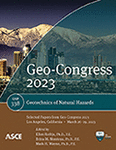Landslide Triggering for Transmission Power Lines in Southern California
Publication: Geo-Congress 2023
ABSTRACT
Power transmission and subtransmission lines in California often face unpredictable climate change, high seismic activity, and geohazards such as slope instability. One such line is a transmission line that traverses over 50 mi of mountainous terrain from Ventura County to Santa Barbara County. Most of the transmission line structures along this line are located in remote mountainous locations and are founded on sedimentary bedrock formations. Some are in landslide terrain, adjacent to mapped landslides, on steep slopes, or on ridgetops. The instability risk for these structures increases with significant precipitation and/or seismic events. Loss or damage to any of these structures due to ground deformation would result in disruption of service to all subtransmission and distribution lines in the service territory. Since the structures’ remote locations make prompt repairs impractical, preventative mitigation is often necessary. However, mitigation is expensive, so measured and targeted mitigation becomes essential. Through a geological desktop study and site visits, the locations of structures that are most prone to landslides were identified. Groundwater mounding modeling, field investigations, and other geotechnical and hydrologic studies were conducted at these sites. The project team estimated peak ground accelerations and spectral accelerations (PGA and SA), with 2% and 10% probability of exceedance in 50 years. They used the historic precipitation data to generate landslide-triggering precipitation criteria and create a monitoring tool to predict rainfall. The probability of exceedance depends on the project life cycle. The team first calculated the factor of safety (FOS) under saturated conditions due to precipitation, and then they calculated the seismic load. The seismic vulnerability was assessed, excluding the impact of storm events. The FOS was calculated based on the project life cycle, where line resiliency is determined using relationships between FOS and the probability of exceedance, considering storm recurrence intervals. In short, this transmission line is a single-point service interruption system prone to landslides, and due to its remote location, it is difficult, time-consuming, and expensive to fix. Mitigation measures were developed and implemented. The approach requires determining which locations pose the highest risk, defining the circumstances that require mitigation, and selecting efficient mitigation measures based on the structure’s resilience.
Get full access to this article
View all available purchase options and get full access to this chapter.
REFERENCES
Abraham, E., and Z. Zafir. Performance-based design of electric power transmission towers against geo-seismic slope displacements.
Anderson, M. P., and W. W. Woessner. 1992. Applied Groundwater Modeling – Simulation of Flow and Advective Transport. San Diego: Academic Press.
Bray, J. D., and T. Travasarou. 2007. Simplified Procedure for Estimating Earthquake-Induced Deviatoric Slope Displacements. ASCE Journal of Geotechnical and Geoenvironmental Engineering, Vol. 133, No. 4, pp. 381–392.
Bouwer, H., J. T. Back, and J. M. Oliver. 1998. “Predicting Infiltration and Ground-Water Mounds for Artificial Recharge.” Journal of Hydrologic Engineering, vol. 4, no. 4, Oct. 1998, p. 350–357., doi:https://doi.org/10.1061/(ASCE)1084-0699(1999)4:4(350).
FEMA. FEMA 302/303 - NEHRP Recommended Provisions for Seismic Regulations for New Buildings and Other Structures. 1997.
Malamud, B., D. Turcotte, F. Guzzetti, and P. Reichenbach. 2004. Landslides, earthquakes, and erosion. Earth Planet. Sc. Lett. 229, 45–59.
NEHRP. Recommended Provisions for Seismic Regulations For New Buildings & Other Structures Part 1: Provisions (FEMA 302).
Polemio, M., and O. Petrucci. Rainfall as a landslide triggering factor: an overview of recent international research, The 8th International Symposium on Landslides in Cardiff. June 2000.
Petersen, M. D., et al. 2014. Documentation for the 2014 Update of the United States National Seismic Hazard Maps.
Rao, K. S., and T. Singh. 2015. Rainfall Thresholds for Landslides: Their Capabilities and Limitations. Journal of Engineering Geology/Proceedings of EGNM 2015.
Santa Barbara County Flood Control and Water Conservation District May 9, 1969.
Soil Strength and Slope Stability, 2005, 1st Edition, by J. Michael Duncan (Author), Stephen G. Wright John Wiley & Sons, INC.
Wieczorek, G. F. 1996. Landslide triggering mechanisms, in Turner, A.K., and Schuster, R.L., eds., Landslides: investigation and mitigation: Special Report 247; Transportation Research Board, National Research Council, p. 76–90.
Wills, C. J., Guitierrez, C. I., Perez, F. G., and Branum, D. M. 2015. “A Next Generation VS30 Map for California Based on Geology and Topography,” Bull. of the Seis. Soc. of Amer., Vol. 106, No. 6, pp 3083–3091.
Information & Authors
Information
Published In
History
Published online: Mar 23, 2023
ASCE Technical Topics:
- Business management
- Climates
- Construction engineering
- Construction management
- Earthquake engineering
- Energy infrastructure
- Engineering fundamentals
- Environmental engineering
- Field tests
- Geohazards
- Geotechnical engineering
- Infrastructure
- Landslides
- Lifeline systems
- Meteorology
- Mitigation and remediation
- Power transmission lines
- Practice and Profession
- Precipitation
- Project management
- Seismic effects
- Seismic tests
- Tests (by type)
Authors
Metrics & Citations
Metrics
Citations
Download citation
If you have the appropriate software installed, you can download article citation data to the citation manager of your choice. Simply select your manager software from the list below and click Download.
